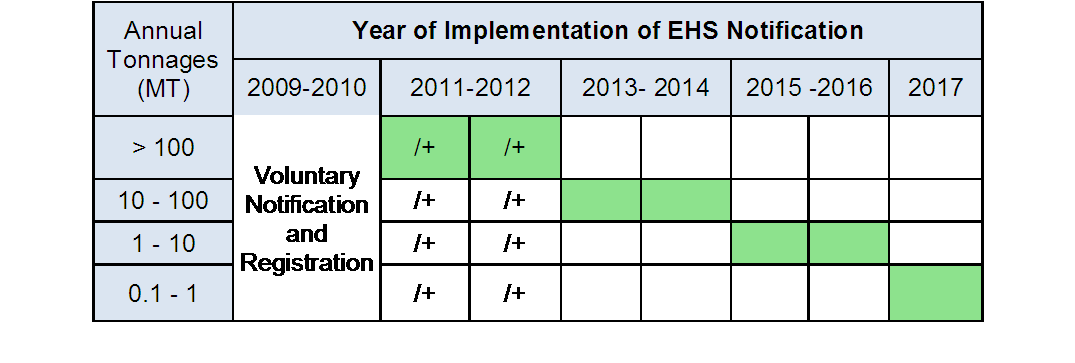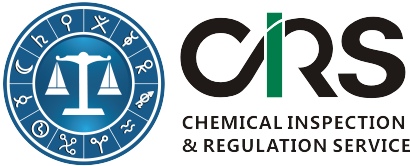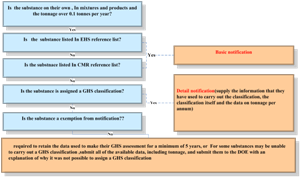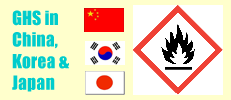Chemical Management in Malaysia(EHSNR)
The Malaysian draft Regulation on "Environmentally Hazardous Substances Notification and Registration " (EHSNR) started on 2 January 2009 under the voluntary notification scheme and will be replaced by a mandatory programme when the regulation comes into force in 2011.
The draft regulation for EHSs notification and registration is now at the final stage and will be forwarded to the relevant government agencies, associations and NGOs for comments in the middle of March 2011. The purpose of the EHS notification and registration is to provide the necessary information to the Malaysian Government that will enable the Department of Environment (DOE) and other agencies involved in chemicals management to identify substances of concern in the country and make decisions about how to manage these substances in a safe and sound manner.
What is the definition of EHS?
An EHS is a substance that is included in the EHS Reference List,
or if not on the list, must be assigned a hazard category under the
GHS classification scheme, as implemented by the Department of
Occupational Safety and Health Malaysia.
Who shall submit EHS notifications?
- Manufacturer of an EHS substance in Malaysia;
- Importer of an EHS substance in Malaysia;
Non Malaysian exporters can appoint third party representatives (TPR) to submit external notifications on behalf of Malaysian importers. Please note that a malaysian legal entity is not required. Substances with volume above 0.1t/y might all be affected.
What information should be submitted during notification?
Chemical companies making the EHS notifications are required to submit a prescribed set of chemical data to the Department of Environment(DOE) in Malaysia.
There are two types of notification: basic notification and detailed notification. Each type of notification applies to different substances.
- Basic notification
for substances on EHS reference list
Only basic information needs to be provided. More specifically, the notifier must provide the following information to the DOE:
a) Substance Identification: (CAS number, EC number. or Code number);
b) Year of Notification;
c) EHS Occurrence: substance or substance present in a mixture or as constituents of finished product;
d) Concentration Range: the range in concentration of a given EHS is defined as the minimum and maximum concentrations, i.e. concentration interval, of the substance in raw materials or finished products;
e) Annual Tonnage of Substance:
f) Details of EHS Uses;
g) Country of export (if imported).
- Detailed notification
for substances not on EHS reference list
Basic notification data and the following data should be provided to DOE in Malaysia.
a) EHS Identification: Molecular Formula, Molecular Structure, Molecular Weight;
b) Physical and Chemical Properties: Physical State at 20C and 101.3 KPa, Colour, Odour, Melting Point, Boiling Point, Flash Point, Auto-Ignition Temperature, Vapour Pressure, Density, Water Solubility, Partition Coefficient in octanol /water (log Kow), Viscosity;
c) Physical Hazards: Explosivity, Flammability, Oxidizability, Self-Reactive, Pyrophoric, Self-Heating, Organic Peroxides, Corrosive to Metals, Gases Under Pressure, Water Activated Flammable Gases;
d) Hazards to Human Health;
e) Hazards to Aquatic Environment:Acute aquatic toxicity, 96 hr LC50, 48 hr EC50, 72 or 96 hr ErC50, Chronic aquatic toxicity, Ready biodegradable, Bioaccumulation, Log Kow.
Companies can find out which type of notification applies by clicking the following diagram:
When is notification deadline?
The tentative phase-in year for the notification based on tonnage is given in the table below.

Substances with volume above 100t/y shall be notified in 2011 and 2012. All substances that, under GHS classification, are assigned an aquatic toxicity classification of "chronic 1" (*) or are suspected or known human carcinogens, reproductive toxicants or mutagens (+) must also be notified during years 2011 and 2012.
How do I know if my substance is exempted or not?
Substances which fall into any of the categories below are totally exempted from the requirements of EHSNR.- The substances not included in the EHS Reference List and not classified as hazardous according to GHS criteria as outlined in CLASS regulation/guidance document;
- The substances which are already regulated by other legislation and N&R schemes in Malaysia viz pesticides and pharmaceuticals;
- The substances in naturally-occurring materials e.g. minerals, ores and ore concentrates as well as cement clinke;
- Incidental/end-use reaction products;
- Substances formed during the manufacture of an article;
- Mixtures (but not mixture components) ;
- Impurities and By-products;
- Non-isolated intermediates i.e. chemical substances used to manufacture other chemical substances that are never separated from the mixture of other chemicals inside a closed system;
- Contained site-limited intermediates;
- Transported intermediates ;
- Substances manufactured solely for export;
- Substances used in research and development;
- Substances produced for test marketing;
- Substances in imported finished consumer products;
- Substances produced in low volume (<0.1 tonnes per annum);
- Substances in mixture or products where the concentration of the substance is below 1 % (0.1 % for carcinogenic substances, substances toxic to reproduction, and category 1 and 2 mutagens).
Are there any sanctions for incompliance?
Yes, the notification of EHS will be mandatory once the Regulation on notification of EHS is gazetted.
About Us
We have provided one-stop chemical inventory search services for many companies doing business in Asia (for example, China, Japan, Korea, Malaysia, and Philippine). We help them find out whether their chemicals are regulated in those countries or regions and offer free initial consultations about how to comply. We also prepare or translate GHS compliant SDS and label in accordance with their national chemical legislation at affordable prices.
If you have any questions about chemical compliance in the Asia-pacific region, please contact:
- CIRS
11F Building 1, Dongguan Hi-Tech Park, 288 Qiuyi Road, Binjiang District, Hangzhou 310052, China
Tel: +86-571 8720 6555 | Fax: +86-571 8720 6533
Email: service@cirs-reach.com





